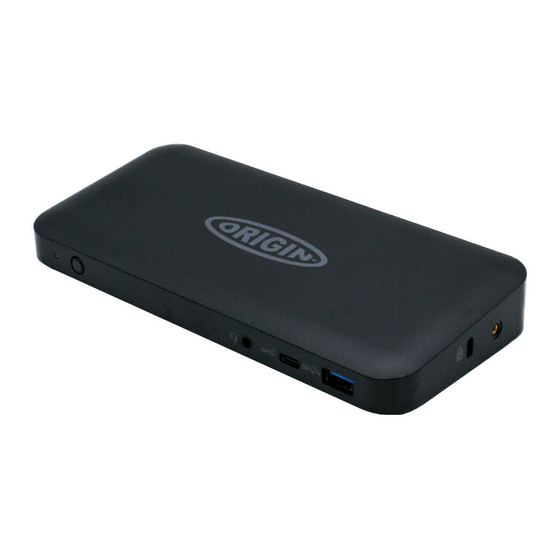
Table of Contents
Advertisement
Advertisement
Table of Contents

Summary of Contents for Origin OSDOCK USBC
- Page 1 OSDOCK USBC - USB C 4K DOCKING STATION...
-
Page 3: Table Of Contents
Table of Contents .......... 1 AFETY NSTRUCTIONS ............1 OPYRIGHT ............1 RADEMARKS REGULATORY COMPLIANCE ......2 FCC C ..........2 ONDITIONS CE ..............2 WEEE I ........... 2 NFORMATION INTRODUCTION ..........3 ............4 EATURES ..........5 ACKAGE ONTENTS ........ - Page 4 ............12 MODE ............12 MODE AUDIO CONFIGURATION ......... 13 SPECIFICATION ..........14...
-
Page 5: Safety Instructions
Before attempting to connect, operate or adjust this product, please save and read the User's Manual completely. The style of the product shown in this User's Manual may be different from the actual unit due to various models. Safety Instructions Always read the safety instructions carefully: Keep this User’s Manual for future reference ... -
Page 6: Regulatory Compliance
Regulatory Compliance FCC Conditions This equipment has been tested and found to comply with Part 15 Class B of the FCC Rules. Operation is subject to the following two conditions: (1) This device may not cause harmful interference. (2) This device must accept any interference received and include interference that may cause undesired operation. -
Page 7: Introduction
Introduction The New OSDOCK USBC - USB C 4K DOCKING STATION is designed for extra connectivity demands and supports DP 1.4 output. With the Docking station, extend the connection of a computer to more USB peripherals, Ethernet network, the speaker and the microphone via USB-C interface. -
Page 8: Features
Features USB-C Input – USB-C 3.1 Gen 2 port – Upstream PD powered, supports up to 85W – Supports VESA USB Type-C DisplayPort Alt mode Downstream Output – 2 x USB-A 3.1 Gen 1 ports (5V/0.9A) – 1 x USB-A 3.1 Gen 2 port with BC 1.2 CDP ( 5V/1.5A ) and DCP and Apple Charge 2.4A ... -
Page 9: Package Contents
Package Contents OSDOCK USBC - USB C 4K DOCKING STATION USB-C Cable Power Adapter User’s Manual System Requirements Windows 10 Mac OS ( Mirror mode only ) -
Page 10: Product Overview
Product Overview Front Item Description Power Button Switch to power on/off 2. Combo Audio Jack Connect to a headset USB-C Port Connect to USB-C devices USB-A Port Connect to USB-A devices with BC 1.2 charging 5. K-Lock Secure your device safety... - Page 11 Rear Item Description 5. Power jack Connect to the power adapter Connect to the USB-C port of a 6. USB-C Port computer 7. DP connector(x2) Connect to a DP monitor HDMI connector Connect to an monitor 9. RJ45 port Connect to an Ethernet USB 3.1 Port (x2) Connect to USB devices...
-
Page 12: Connection
Connection To connect the USB peripherals, Ethernet, speaker and microphone, follow the illustrations below to connect the corresponding connectors. -
Page 13: Display Configuration
Display configuration NOTE: The screenshots might vary slightly with the operating system. Multi-monitor configuration Once the extra monitors are connected, they can be configured to either Mirror mode, Extend mode or set the primary display. Position the mouse anywhere on the Windows Desktop, Right-click and select Screen Resolution. -
Page 14: Extend Mode
Extend mode 1. Refer to the Multi-monitor configuration section to bring up the configuration window. 2. In the Display drop-down menu, select the preferred monitor. 3. Select Multiple Displays > Extend these displays. 4. Click OK to confirm and exit. 5. -
Page 15: Mirror Mode
6. Troubleshooting Cursor disappeared If the status remains in the extended mode but the docking station is disconnected, the desktop will still be panned to the add-on monitor. The cursor may not be found on the primary monitor in such a case. If it happens, connect the add-on monitor through the docking station again or keep moving the mouse. -
Page 16: Set The Primary Monitor
Set the primary monitor 1. Refer to the Multi-monitor configuration section to bring up the configuration window. 2. In the Display drop-down menu, select the preferred monitor. 3. Check the box of Make this my main display. NOTE: For some computers, you may need to disable the main display by unchecking the box of Extend the desktop onto this monitor or Extend my Windows desktop onto this monitor. - Page 17 Audio configuration By default, when the docking station is connected to a computer, the audio configuration may be changed to USB (Multimedia) Audio Device automatically (this setting depends on models). If it does not work, follow the steps below to setup. 1.
- Page 18 Specification Upstream USB-C female connector User Interface DP female connector x2 Downstream female connector x1 USB 3.1 female connector x4 (3A1C), one port supports BC 1.2/CDP RJ45 connector x1 Combo Audio Jack (IN/OUT) x1 Single display, either one Video Resolution –...
- Page 20 OSDOCK USBC - USB C 4K DOCKING STATION V1.0 User's Manual...

Need help?
Do you have a question about the OSDOCK USBC and is the answer not in the manual?
Questions and answers